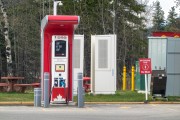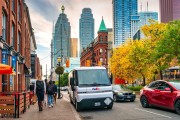Anyone who has travelled on King Street during rush hour is painfully aware that the corridor design – for transit, cars and pedestrians – needs a rethink. After years of Torontonians collectively dreaming of a more efficient King Street, and the launch of the visioning study last spring, the city’s planning team made an exciting step forward last night with the release of pilot options. Innovative and flexible, these options are on the right track to get King Street moving.
Toronto is lucky to have a network of streetcars. Compared to buses, streetcars can move more people, cost less to operate, and have a much lower impact on air quality. However, to make the best use of this asset, we need design solutions to help streetcars and cars move in harmony.
The planning team has stated that the primary goal of the pilot will be “moving people.” We applaud this as the right goal for King Street. With 65,000 daily transit riders compared to 20,000 vehicles, we need to solve the chronic unreliability of the King streetcar. A well-designed pilot would allow for the expansion of transit service while improving efficiency to incentivize more people to choose transit, instead of options like cars or taxis.
The options
The pilot options are proposed between Bathurst and Jarvis or Parliament Streets, where transit delays are most common. The three major block options currently on the table are: separated lanes, alternating loops, and transit promenade. The second and third options could include cycling infrastructure. See last night's presentation for an overview.
It’s great to see that each of the options will reorganize lanes to increase transit reliability and reduce travel times. The proposals maintain vehicle access where necessary, while expanding public space where possible. The options are not unlike the highly successful transit priority project on Church Street in San Francisco. During the upcoming public consultation process, we encourage the planning team to continue to consider what options will best move the most people efficiently along the King Street.
The right solution for King Street will likely be a combination of these block options along different parts of the corridor. The crux of the public consultation process will be to determine the right option for each segment. This is where the knowledge of local businesses, residents and road users comes in. Where must we maintain driveway and delivery access for goods? Where would businesses and institutions benefit from more expanded public space? We also need to see King Street as part of the broader downtown network. At 20 metres wide, King Street can’t do it all – other corridors must play a complementary role.
Keeping the momentum
The beauty of a pilot project is that cheap, temporary interventions are used to test approaches before making final decisions. By establishing the right metrics – another key part of the public consultation process – and transparently measuring the results, we can find the best solution for King Street.
Road users will need time to adjust, so communication, education and signage will be as important as the physical interventions. The duration of the pilot will need to be long enough to measure performance in different seasons, but short enough to keep momentum and refine the interventions as needed.
Following the public consultation process, a refined recommendation for the pilot is expected to go to city council for consideration this summer, with the hope of a pilot launch in fall 2017. In the meantime, we’ll be contributing to the public consultation, and keeping our eyes on King Street.






